
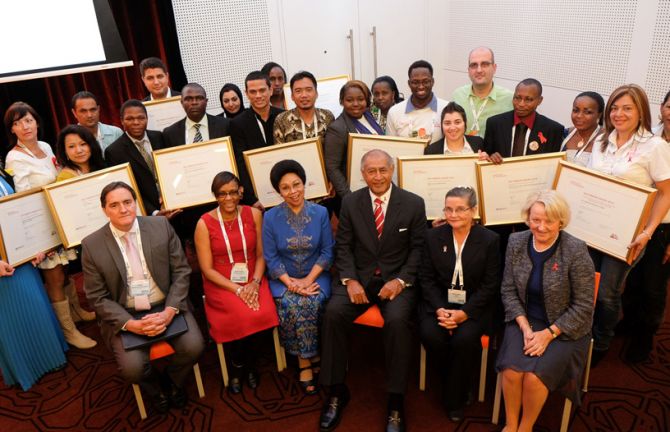
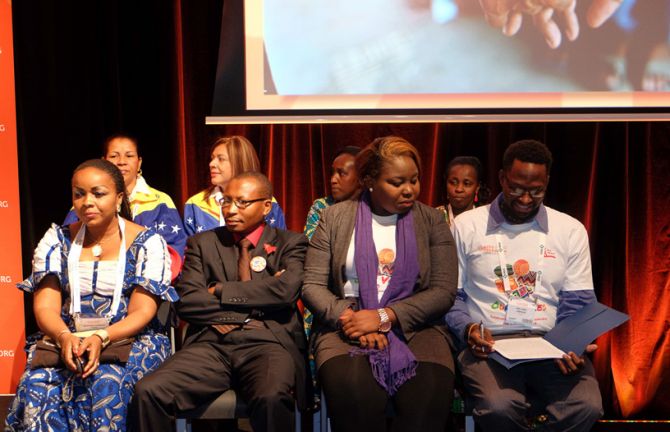
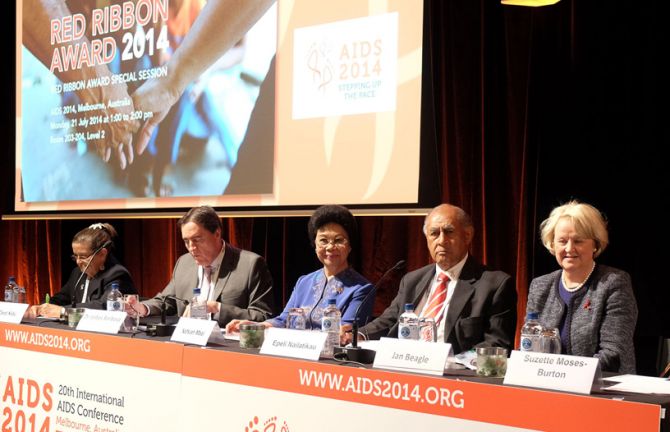
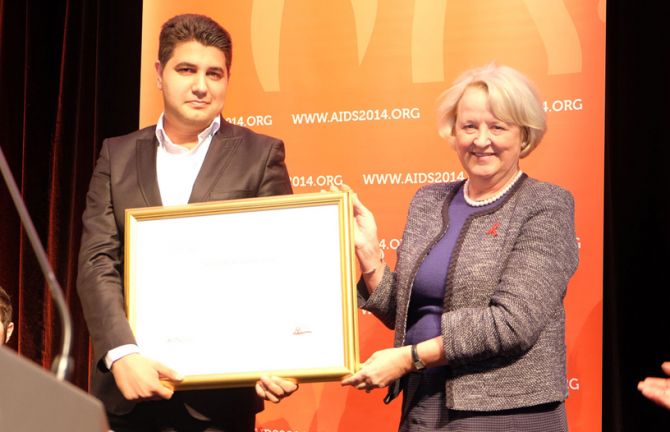
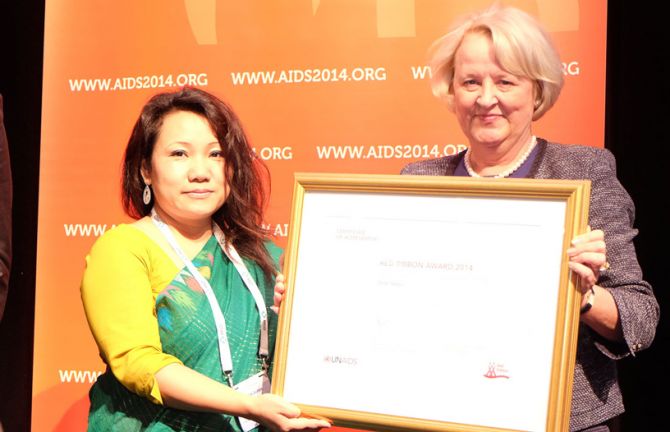
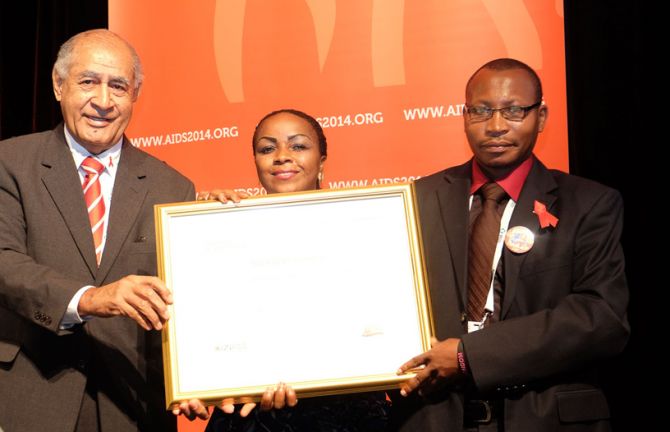
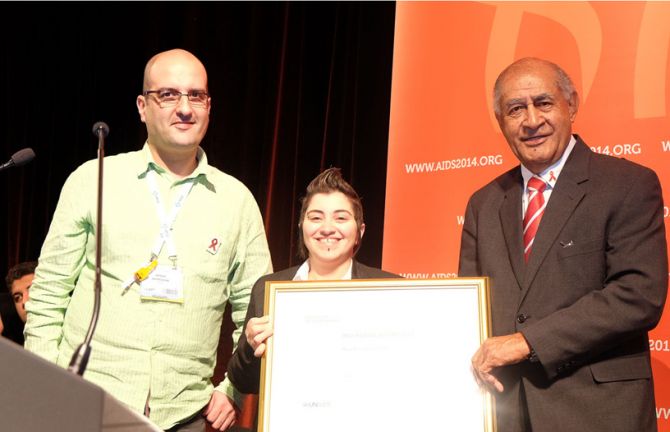
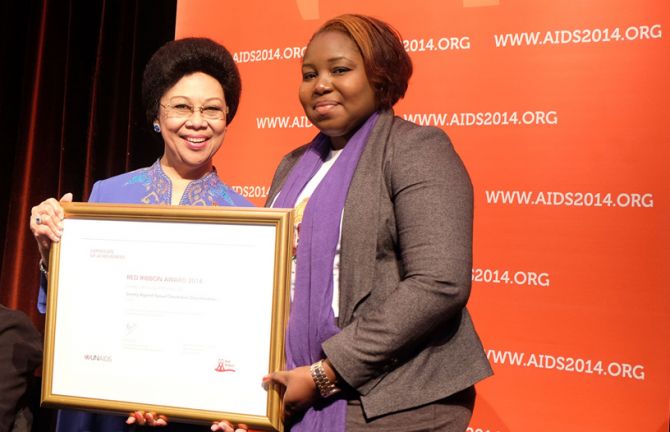
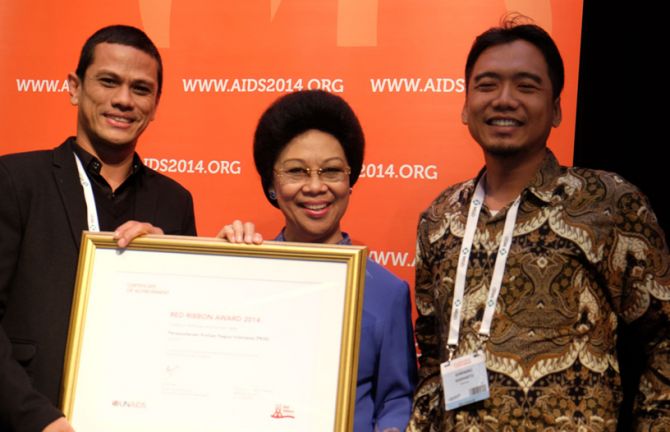
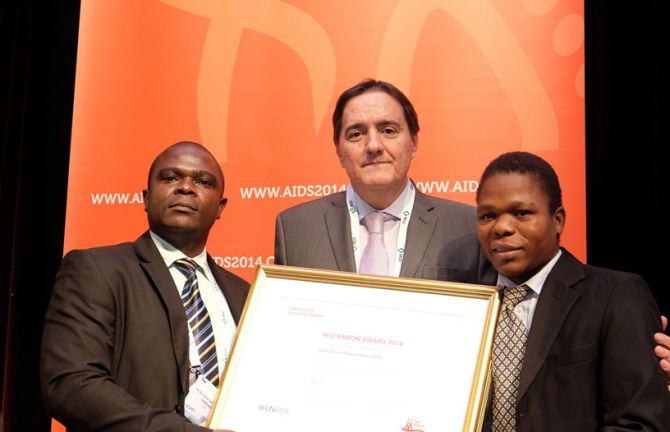
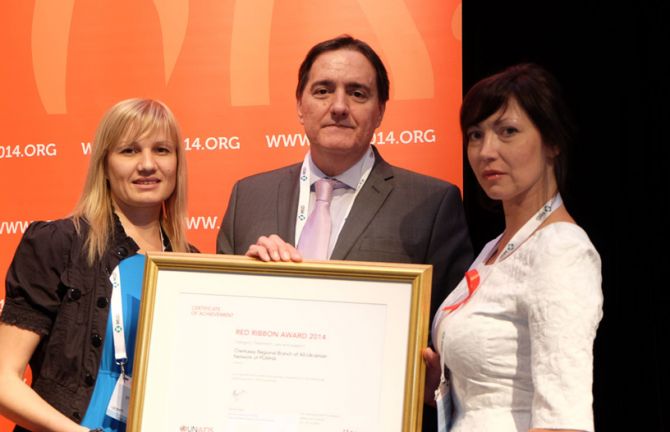
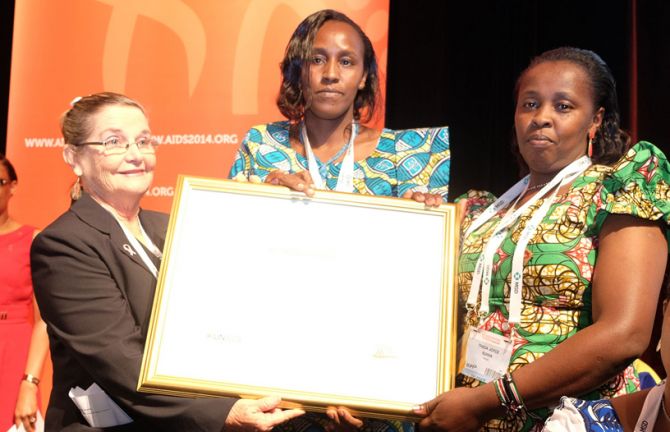
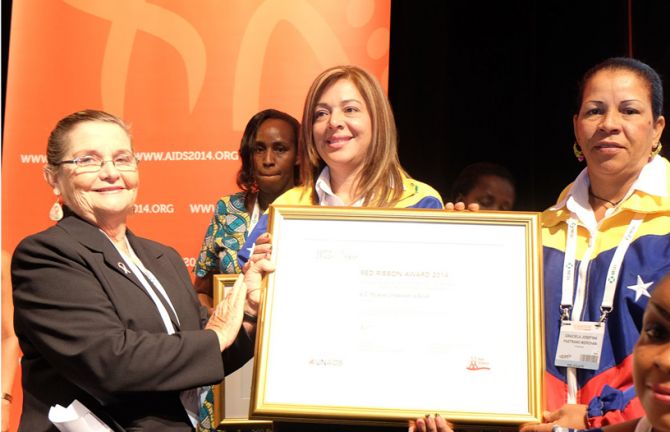
Press Release
Ten organizations receive Red Ribbon Award for outstanding community leadership on AIDS
21 July 2014 21 July 2014MELBOURNE, 21 July 2014—Ten exceptional community-based organizations have won the 2014 Red Ribbon Award for their inspiring work in reducing the impact of the AIDS epidemic. They were presented with the prestigious prize in a special session at the 20th International AIDS Conference (AIDS 2014) in Melbourne, Australia. The Red Ribbon Award is the world’s leading award for innovative and outstanding community work in the response to the AIDS epidemic.
Community-based organizations have shown the world how to mobilize for change in the AIDS response and the Red Ribbon Award recognizes their transformative achievements.
“In villages and townships across the globe, communities have taken matters into their own hands and come up with innovative solutions to what often appear as insurmountable problems in the AIDS response,” said UNAIDS Executive Director Michel Sidibé. “I congratulate the winners of the Red Ribbon Award 2014 for their courage, determination and dedication. Their leadership and cutting-edge thinking have brought us to where we are today.”
The 2014 winning organizations are from the Democratic Republic of the Congo, Guyana, Indonesia, Iran (Islamic Republic of), Kenya, Lebanon, Malawi, Nepal, Ukraine and Venezuela (Bolivarian Republic of). Almost 1000 nominations from more than 120 countries were received by the Red Ribbon Award secretariat, which is hosted by UNAIDS in partnership with other United Nations organizations, AIDS 2014, the Global Network of People Living with HIV, the International Community of Women Living with HIV/AIDS, the International Council of AIDS Service Organizations and Irish Aid. A global panel of civil society representatives selected the finalists from a shortlist determined by regional panels. Each of the winning organizations will receive a US$ 10 000 grant and have been invited to participate in AIDS 2014.
At the Red Ribbon Award special session, the winners were congratulated by Epeli Nailatikau, President of Fiji, Nafsiah Mboi, Minister of Health of Indonesia, Dr. Jarbas Barbosa, Vice Minister of Health of Brazil, Dame Carol Kidu, former Member of Parliament of Papua New Guinea and Jan Beagle, Deputy Executive Director, Management and Governance, UNAIDS.
President Nailatikau said, “This award honours the incredible innovation taking place at the grass roots. I am proud to give this award to organizations whose actions in the communities they serve truly make a huge difference to people affected by HIV.”
The Red Ribbon Award was first presented in 2006 and since then has been handed out every two years at the International AIDS Conference. This year there were five award categories. The 10 winners are listed below by category.
Category one: Prevention of sexual transmission
Action pour la Lutte contre l’Ignorance du SIDA (ALCIS) is a community-based organization founded in 1999 to prevent sexual transmission of HIV among young people and men who have sex with men in the context of sex work. It is the only organization in the Democratic Republic of the Congo to organize sex workers and men who have sex with men into solidarity committees that represent a collective and cooperative entity.
Marsa Sexual Health Centre provides marginalized sexually active young people, women, lesbian, gay, bisexual, transsexual, transgender and intersex people (LGBTI) and people living with HIV full access to sexual and reproductive health services.
Category two: Prevention among/by people who use drugs
Ehyaye Hayyate Sarmad is best known for its Red Ribbon Prison, which has provided treatment for drug users and organized workshops on sexual and reproductive health. Ehyaye Hayyate Sarmad is one of the first organizations in the Islamic Republic of Iran to work in the field of harm reduction and HIV in the prison system.
Dristi provides services and support to women who use drugs in Nepal. The organization is run by women who are former drug users and is dedicated to reducing the harmful impact of drug use through advocacy, treatment and support.
Category three: Treatment, care and support
Life Concern Organization (LICO) helps to improve the health and development of marginalized and vulnerable populations in Malawi. Since February 2009, LICO has worked to empower and lead an engaged community that can make informed decisions in the Rumphi district of northern Malawi.
Cherkassy Regional Branch of All-Ukrainian Network of PLWHA started as a self-help group to support the HIV-positive community. Over the past 12 years, the organization has worked to create systematic change at the regional level and to improve the quality of life through treatment, diagnosis and accompaniment for people living with HIV.
Category four: Advocacy and human rights
Society against Sexual Orientation Discrimination (SASOD) is dedicated to the eradication of homophobia in Guyana and throughout the Caribbean. SASOD has worked to repeal discriminatory Guyanese laws, change local attitudes about the LGBTI community and end discrimination in the government, workplace and community.
Perssaudaraan Korban Napza Indonesia (PKNI) is a leading national network representing the common priorities of 25 self-organized drug user groups across 19 provinces in Indonesia. PKNI was established in 2006 to address stigma, violence, discrimination and violations of human rights towards people who use drugs.
Category five: Stopping new HIV infections among children and keeping mothers alive, women’s health
Girl Child Counseling Women’s Group is a grass-roots women’s group that focuses on bringing together all community members to address the high rate of new HIV infections among women of childbearing age in Matunda, Kenya. The group vision is “A HIV free generation in the Matunda location.”
AC Mujeres Unidas por la Salud was created as a nongovernmental organization in the Bolivarian Republic of Venezuela in 2003 and is led by 35 women. Over the past years it has become an organization of reference at the national level for women living with HIV as a result of their efforts. It provides spaces where women can receive counselling, information and support.
For further information about this year’s winners and the Red Ribbon Award, please see the Red Ribbon Award website at www.redribbonaward.org.
The 2014 Red Ribbon Award on Social Media
Facebook: https://www.facebook.com/redribbon2014/timeline
Twitter: https://twitter.com/2014RedRibbon
About the Sponsors
UNAIDS
The Joint United Nations Programme on HIV/AIDS (UNAIDS) leads and inspires the world to achieve its shared vision of zero new HIV infections, zero discrimination and zero AIDS-related deaths. UNAIDS unites the efforts of 11 UN organizations—UNHCR, UNICEF, WFP, UNDP, UNFPA, UNODC, UN Women, ILO, UNESCO, WHO and the World Bank—and works closely with global and national partners to maximize results for the AIDS response. Learn more at unaids.org and connect with us onFacebook and Twitter.
UN partners
The UN partners involved in the Red Ribbon Award initiative bring together the efforts and resources of all UNAIDS Cosponsors and the UNAIDS Secretariat.
AIDS 2014
The XX International AIDS Conference (AIDS 2014) is the premier gathering for those working in the field of HIV, as well as policy makers, persons living with HIV and other individuals committed to ending the pandemic. It is a chance for stakeholders to take stock of where the epidemic is, evaluate recent scientific developments and lessons learnt, and collectively chart a course forward. AIDS 2014 will be held in Melbourne, Australia from 20 to 25 July 2014. (www.aids2014.org). The International AIDS Society is the convener and custodian of the conference.
Global Network of People Living with HIV
GNP+ is the global network for and by people living with HIV. GNP+ advocates to improve the quality of life of people living with HIV. Driven by the needs of people living with HIV worldwide, GNP+ supports people living with HIV through their organizations and networks. GNP+ works to ensure equitable access to health and social services, by focusing on social justice, rights and more meaningful involvement of people living with HIV in programme and policy development – the GIPA principle. (www.gnpplus.net)
International Community of Women Living with HIV/AIDS
ICW Global emerged to look for answers facing the desperate lack of support, information and services available for women living with HIV. The organization promotes the leadership and involvement of women living with HIV in spaces where policies and programmes are developed and implemented and where the decisions that affect the life of thousands of people who live with the virus are made. The vision is for a just world where women living with HIV are leaders in HIV programmes and policy and realize their universal rights. They dream of a world where women, young women, girls, adolescents living with HIV have full access to care and treatment and enjoy all of their rights: sexual, reproductive, legal, economic and health, regardless of culture, age, religion, sexuality, race or socio-economic status. (www.icwglobal.org)
International Council of AIDS Service Organizations
Founded in 1991, the International Council of AIDS Service Organizations’ (ICASO) mission is to mobilize and support diverse community organizations to build an effective global response to end AIDS. This is done within a vision of a world where people living with and affected by HIV can enjoy life free from stigma, discrimination, and persecution, and have access to prevention, treatment and care. The ICASO network operates globally, regionally and locally, and reaches over 100 countries internationally. (www.icaso.org)
Irish Aid
Irish Aid is the Government of Ireland's programme of assistance to developing countries. Its aid philosophy is rooted in Ireland's foreign policy, in particular its objectives of peace and justice. The international development policy "One World, One Future" reflects Ireland's longstanding commitment to human rights and fairness in international relations and is inseparable from Irish foreign policy as a whole. The Irish Aid programme has as its absolute priority the reduction of poverty, inequality and exclusion in developing countries, with a strong geographic focus on Sub-Saharan Africa. Improving access to quality essential social services such as health, education, services related to HIV and AIDS, and social protection is seen as key to the realisation of human rights, the reduction of poverty, hunger and inequality and the promotion of inclusive economic growth. (http://www.irishaid.gov.ie)
About the Red Ribbon Award
The red ribbon is a global symbol in the movement to address AIDS. The Red Ribbon Award, presented every two years at the International AIDS Conference, is designed to honor and celebrate community based organizations for their outstanding initiatives that show leadership in reducing the spread and impact of AIDS. The award is a joint effort of the UNAIDS family and as such, this year it will place particular emphasis on the organization's newly approved global priority areas of action.
The Red Ribbon Award was first given in 2006 and has recognized 85 organizations from over 50 different countries since then as leading community-based responses to AIDS. Such organizations lie at the heart of the response to the AIDS epidemic – displaying extraordinary courage, resilience and strength in addressing one of the greatest challenges of our time. Using creative and sustainable ways to promote prevention of sexual transmission, and prevention among people who use drugs, provide treatment, care, and support to people living with HIV and demonstrating innovation in the face of stigma and discrimination through advocacy and human rights, and stopping new HIV infections in children and keeping mothers alive, and taking care of women’s health, these examples of community leadership are showing us in practical terms how to reverse a global epidemic – one community at a time.
Right Hand side
Press centre
Download the printable version (PDF)

Press Release
UNAIDS report shows that 19 million of the 35 million people living with HIV today do not know that they have the virus
16 July 2014 16 July 2014In sub-Saharan Africa, nearly 90% of people who know their HIV-positive status are on treatment—ending the AIDS epidemic by 2030 will require smart scale-up to close the gap
GENEVA, 16 July 2014—A new report by UNAIDS shows that 19 million of the 35 million people living with HIV globally do not know their HIV-positive status.
“Whether you live or die should not depend on access to an HIV test,” said Michel Sidibé, Executive Director of UNAIDS. “Smarter scale-up is needed to close the gap between people who know their HIV status and people who don’t, people who can get services and people who can’t and people who are protected and people who are punished.”
The UNAIDS Gap report shows that as people find out their HIV-positive status they will seek life-saving treatment. In sub-Saharan Africa, almost 90% of people who tested positive for HIV went on to access antiretroviral therapy (ART). Research shows that in sub-Saharan Africa, 76% of people on ART have achieved viral suppression, whereby they are unlikely to transmit the virus to their sexual partners. New data analysis demonstrates that for every 10% increase in treatment coverage there is a 1% decline in the percentage of new infections among people living with HIV.
The report highlights that efforts to increase access to ART are working. In 2013, an additional 2.3 million people gained access to the life-saving medicines. This brings the global number of people accessing ART to nearly 13 million by the end of 2013. Based on past scale-up, UNAIDS projects that as of July 2014 as many as 13 950 296 people were accessing ART.
“If we accelerate all HIV scale-up by 2020, we will be on track to end the epidemic by 2030,” said Mr Sidibé. “If not, we risk significantly increasing the time it would take—adding a decade, if not more.”
By ending the epidemic by 2030, the world would avert 18 million new HIV infections and 11.2 million AIDS-related deaths between 2013 and 2030.
Ending the AIDS epidemic
The report reveals that just 15 countries* account for more than 75% of the 2.1 million new HIV infections that occurred in 2013. In every region of the world the report finds that there are three or four countries that bear the burden of the epidemic. In sub-Saharan Africa, just three countries—Nigeria, South Africa and Uganda—account for 48% of all new HIV infections.
However, the report also shows that entire countries are being left behind—for example, six nations—Central African Republic, Democratic Republic of the Congo, Indonesia, Nigeria, Russian Federation and South Sudan—are facing the triple threat of high HIV burden, low treatment coverage and no or little decline in new HIV infections.
In the first report of its kind, the UNAIDS Gap report emphasizes the importance of location and population through an in-depth regional analysis of HIV epidemics and through analysis of 12 populations at higher risk of HIV. It analyses the reasons for the widening gap between people gaining access to HIV prevention, treatment, care and support, and people being left behind. It shows how focusing on populations that are underserved and at higher risk of HIV will be key to ending the AIDS epidemic.
HIV prevalence is estimated to be 28 times higher among people who inject drugs, 12 times higher among sex workers, 19 times higher among gay men and other men who have sex with men and up to 49 times higher among transgender women than among the rest of the adult population. In sub-Saharan Africa, adolescent girls and young women account for one in four new HIV infections. The report looks at why certain populations are not accessing HIV services and outlines the urgent need to address their specific needs.
“There will be no ending AIDS without putting people first, without ensuring that people living with and affected by the epidemic are part of a new movement,” said Mr Sidibé. “Without a people-centred approach, we will not go far in the post-2015 era.”
The report shows that it is both essential and possible to go deeper than a country-wide approach. Because countries and regions have multiple and varying epidemics, the report outlines that having country targets and sound policies in place creates space to address complex micro-epidemics with tailored, bite-sized solutions that will help reach people faster with better HIV services. It notes that cities and communities will play an increasingly major role in effective scale-up.
However, the report also shows that a lack of data on people most affected by HIV, coupled with widespread stigma and discrimination, punitive legal environments, barriers to civil society engagement and lack of investment in tailored programmes are holding back results. It confirms that countries that ignore discrimination and condone inequalities will not reach their full potential, and face serious public health and financial consequences of inaction. The report emphasizes the need for equal access to quality HIV services as both a human rights and public health imperative.
Hope and gaps
UNAIDS is reporting the lowest levels of new HIV infections this century, at 2.1 million [1.9 million–2.4 million]. In the last three years alone new HIV infections have fallen by 13%.
It is estimated that 35 million people were living with HIV in the world at the end of 2013. AIDS-related deaths are at their lowest since the peak in 2005, having declined by 35%. Tuberculosis continues to be the leading cause of death among people living with HIV.
New HIV infections among children have fallen by 58% since 2001 and dropped below 200 000 for the first time in the 21 most affected countries in Africa.
The highest number of people living with HIV was in sub-Saharan Africa—24.7 million [23.5 million–26.1 million] people. Asia and the Pacific had the next largest population of people living with HIV, at an estimated 4.8 million [4.1 million–5.5 million] people.
The percentage of people living with HIV who were receiving treatment was found to be highest in western Europe and North America, at 51% [39–60%], and in Latin America, at 45% [33–51%]. However, coverage was lowest in the Middle East and North Africa, at just 11% [8–16%].
New HIV infections declined most in the Caribbean—by 40% since 2005; however, new HIV infections have risen by 7% in the Middle East and North Africa and by 5% in eastern Europe and central Asia since 2005.
AIDS-related deaths were seen to be rising steeply in the Middle East and North Africa, by 66%. The only other region where AIDS-related deaths are increasing is eastern Europe and central Asia, where AIDS-related deaths rose by 5% between 2005 and 2013.
The report outlines that to close the gap between people who are reached with HIV services and people who are not will require research and innovation combined with protective laws that promote freedom and equality for all people. It will also require increased commitment from the global community and countries most affected to the remarkable returns on investment that have been witnessed over the last 10 years to continue so that the end of the AIDS epidemic can be achieved by 2030.
UNAIDS is providing video footage (broll and video news release) for broadcasters, as well as excerpts from the report launch press conference. http://www.unaids.org/en/resources/campaigns/2014/2014gapreport/videofootage/
*Brazil, Cameroon, China, India, Indonesia, Kenya, Mozambique, Nigeria, Russian Federation, South Africa, Uganda, United Republic of Tanzania, USA, Zambia, Zimbabwe.
UNAIDS
The Joint United Nations Programme on HIV/AIDS (UNAIDS) leads and inspires the world to achieve its shared vision of zero new HIV infections, zero discrimination and zero AIDS-related deaths. UNAIDS unites the efforts of 11 UN organizations—UNHCR, UNICEF, WFP, UNDP, UNFPA, UNODC, UN Women, ILO, UNESCO, WHO and the World Bank—and works closely with global and national partners towards ending the AIDS epidemic by 2030 as part of the Sustainable Development Goals. Learn more at unaids.org and connect with us on Facebook, Twitter, Instagram and YouTube.

Press Statement
UNAIDS welcomes Australia’s commitment to equal treatment of people living with HIV in its immigration policies
10 July 2014 10 July 2014HIV treated as other chronic conditions in immigration health assessment.
GENEVA, 10 July 2014—UNAIDS welcomes confirmation from the Government of Australia that people living with HIV do not face an automatic exclusion, or unequal treatment when applying for entry, stay or residence visas. People living with HIV are treated similarly to other people with chronic health conditions and disabilities during the country’s immigration health assessment process. Applications for visas from people living with HIV will be assessed against criteria applying to anyone with a chronic health condition.
The announcement came ahead of the 20th International AIDS Conference, which will take place in Melbourne, Australia, from 20 to 25 July 2014.
“People living with HIV need equal opportunity to contribute to and benefit from today’s globalized world, where migration is increasingly important. Eliminating travel restrictions is not only a human right for individuals, it improves business prospects for communities,” said the Executive Director of UNAIDS, Michel Sidibé.
UNAIDS advocates for the right to equal freedom of movement, regardless of HIV status. There is no evidence that restrictions on the entry, stay or residence of people living with HIV protect the public’s health. In 2012, more than 40 chief executives from some of the world’s largest companies signed a pledge opposing HIV restrictions, calling them discriminatory and bad for business.
As part of its ongoing dialogue with countries on this issue, UNAIDS has sent communications to all countries, territories and areas that appear to have HIV-related entry, stay and residence restrictions, and has raised the issue during official high-level visits. Australia has made important reforms to its migration health assessment requirements and procedures since the conclusion of a parliamentary inquiry on migration and disability in 2010, including an annual increase to the “significant cost threshold”, the elimination of the cost assessment related to health services for humanitarian visa applicants and improvements to increase the transparency of the health assessment process. These reforms were assessed against the criteria outlined by the International Task Team on HIV-related Travel Restrictions, co-chaired by the Government of Norway and UNAIDS, and it was concluded that Australia had met the task team’s standard.
UNAIDS
The Joint United Nations Programme on HIV/AIDS (UNAIDS) leads and inspires the world to achieve its shared vision of zero new HIV infections, zero discrimination and zero AIDS-related deaths. UNAIDS unites the efforts of 11 UN organizations—UNHCR, UNICEF, WFP, UNDP, UNFPA, UNODC, UN Women, ILO, UNESCO, WHO and the World Bank—and works closely with global and national partners to maximize results for the AIDS response. Learn more at unaids.org and connect with us on Facebook and Twitter.

Press Release
UNAIDS Board calls for ending the AIDS epidemic as a public health threat by 2030
04 July 2014 04 July 2014GENEVA, 4 July 2014—The 34th meeting of UNAIDS Programme Coordinating Board has concluded in Geneva after three days of discussions and debate. The importance of ensuring the inclusion of HIV in the post-2015 sustainable development goals, ending the AIDS epidemic by 2030 and social protection were topics high on the agenda.
During the meeting, the UNAIDS Board members recognized the value of the lessons learned from the Joint Programme’s unique approach to enhancing strategic coherence, coordination, results-based focus and country-level impact. The Board also called on UNAIDS and United Nations Member States to pursue a clear commitment in the post-2015 development agenda to ending the AIDS epidemic as a public health threat by 2030. The Board stressed that ending the AIDS epidemic would be provisionally defined as the reduction of new HIV infections, stigma and discrimination experienced by people living with HIV and key populations, and AIDS-related deaths by 90% compared to 2010 levels.
The Executive Director of UNAIDS, Michel Sidibé presented his report to the Board and encouraged Board members to develop new and unconventional ways of thinking and approaches to end the AIDS epidemic by 2030. “This is a singular opportunity to set an ambitious course that will ensure that we have the political space and resources to get the job done,” he said.
At the meeting which took place from 1 to 3 July 2014 in Geneva, Switzerland, Board members were joined for the opening session by Sir Andrew Witty, Chief Executive of GlaxoSmithKline who talked about developing new medicines and the need for customised solutions, and Mr Subhanu Saxena, Chief Executive Officer of Indian generics manufacturer Cipla, who stressed the importance of innovation and the need to increase access to generic medicines.
The meeting concluded with a full-day thematic segment on social protection. Speakers included people living with HIV and from key populations at higher risk of HIV, members of civil society, government representatives and health and development experts who talked about the urgent need to address the social and economic drivers of HIV through social protection measures including financial incentives such as cash transfers, pension schemes, housing and lower cost transport options.
Participants and observers from UN Member States, international organizations, civil society and non-governmental organizations attended the meeting, which was chaired by Australia with Zimbabwe as vice chair. The Board elected El Salvador as rapporteur for 2014.
UNAIDS Executive Director’s report to the Board, and the Board’s decisions from the meeting can be found at www.unaids.org

Press Release
UNAIDS and partners launch initiative to improve HIV diagnostics
23 July 2014 23 July 2014Partners will advocate for increased funding and price reductions, strengthen efforts to ensure highest quality diagnostic services and forge partnerships to close diagnostic access gaps.
MEBOURNE/GENEVA, 23 July 2014—The Joint United Nations Programme on HIV/AIDS (UNAIDS) has joined with global and regional partners to launch the Diagnostics Access Initiative which calls for improving laboratory capacity to ensure that all people living with HIV can be linked to effective, high-quality HIV treatment services.
Partners in the initiative include UNAIDS, the World Health Organization (WHO), the Clinton Health Access Initiative, the African Society for Laboratory Medicine (ASLM), UNICEF, and the US President’s Emergency Plan for AIDS Relief (PEPFAR).
"Around 19 million of the 35 million people living with HIV don’t know they have the virus. If they don’t find out they will die,” said Michel Sidibé, UNAIDS Executive Director. “This is why we have to make it simpler for people to test for HIV to be able to start lifesaving treatment when they need it.”
The Diagnostics Access Initiative specifically focuses on ensuring that at least 90% of all people living with HIV know their HIV status. It also aims to ensure that all people accessing HIV treatment have ready access to tests that monitor the levels of the virus in their bodies.
For treatment to be optimally effective, it is essential that all people accessing HIV treatment monitor their viral load frequently. Currently very few high-burden countries routinely offer viral load testing to people receiving HIV treatment. New viral load testing technologies which are made available when people first come in for care, offer promise for expanding access to viral load testing. However they will need to be affordable, appropriately deployed and used effectively.
“To achieve control of the HIV/AIDS epidemic, it’s essential that all people have access to high-quality HIV laboratory services, both for accurate HIV diagnosis and treatment monitoring. Building a country’s capacity for virologic testing is critical for early identification of virologic failure, drug resistance and overall improved impact of the country’s HIV care and treatment programs,” said Ambassador Deborah Birx, U.S. Global AIDS Coordinator. “The Diagnostic Access Initiative represents an important step in ensuring the close collaboration among all donors and stakeholders to expand access and enable strategic scale-up of HIV laboratory services.”
To ensure early diagnosis of HIV, laboratory procedures need to be simplified and multiple testing tools and strategies made available. These also need to be integrated into community-centred health campaigns that focus on multiple diseases.
“It is essential that people know whether they have HIV infection, and that people who take treatment know whether their medicines are controlling the virus,” said Dr Hiroki Nakatani, Assistant Director-General, WHO. “As diagnostic technology changes rapidly, and our Member States need guidance on how to use it, WHO will play a key role in this initiative.”
HIV treatment is effective in reducing HIV-related illness and AIDS-related deaths. It also helps to prevent new HIV infections, by sharply suppressing viral load and decreasing the risk of HIV transmission.
“The Diagnostic Access Initiative focuses urgent attention on the importance of developing new, affordable viral load and infant diagnosis technologies and effectively using the laboratory capacity we currently have,” said Dr. Tsehaynesh Messele, Chief Executive Officer of ASLM. “Effectively using existing and emerging viral load and infant diagnosis technologies will demand substantially stronger laboratory capacity as well as strategic planning to ensure that all technologies are optimally used.”
Partners in the initiative will advocate for greater funding for laboratory services and for the development of new diagnostic tools. They will also strengthen efforts to ensure that diagnostic services are of the highest quality and forge well-coordinated partnerships to close diagnostic access gaps.

Press Release
Declining investment could slow research and rollout of new HIV prevention options
18 July 2014 18 July 2014Report shows prevention R&D funding falls 4% due to public sector research budget reductions in US, Europe
Melbourne, Australia, 18 July 2014 – Investment in HIV prevention research fell US$50 million, or 4 percent, to US$1.26 billion in 2013, due to declining investments by the United States and European government donors, changes in the international development landscape and changes in the pipeline of HIV prevention products in various stages of development and implementation, according to a new report from the HIV Vaccines and Microbicides Resource Tracking Working Group.
HIV Prevention Research & Development Investment in 2013: In a changing global development, economic, and human rights landscape is the tenth annual report by the Working Group, a collaboration between AVAC, UNAIDS, and the International AIDS Vaccine Initiative (IAVI). The report summarizes investment in HIV prevention research across seven prevention options. The report was released today ahead of the 20th International AIDS Conference (AIDS 2014) in Melbourne, Australia. Breakdowns by prevention modality are available in the full report at www.hivresourcetracking.org.
Despite overall US budget cuts in 2013 and a decline in support for HIV prevention research, the US government remains the single largest funder of prevention research, accounting for more than 70 percent of total investment over the past five years. The US contribution decreased US$44 million to US$881 million in 2013, largely due to automatic, across the board cuts to all federally funded programs as a result of sequestration. Funding from European government donors, including 12 countries and the European Commission, was also reduced as priorities for international development in some countries have continued to shift.
“Research and development has produced a valuable range of medicines, diagnostics and devices to prevent and treat HIV which have to be made more widely available. However, funding is declining at a time when services need to be expanded and better treatments and additional HIV prevention options are needed,” said Luiz Loures, Deputy Executive Director, UNAIDS. “Now is not the time to pull back from science, but rather to push forward towards ending the AIDS epidemic.”
Investment declined in research & development related to voluntary medical adult male circumcision (VMMC) and female condoms, both options that have long been proven effective and are now being scaled-up as part of broader HIV prevention programs. Investment increased for R&D related to treatment as prevention (TasP) and pre-exposure prophylaxis (PrEP), which have more recently proven effective and now require additional research to support wide scale implementation.
Vaccine R&D in 2013 also saw the largest real decrease in investment since such research began, with the effects of U.S. sequestration, reduced bilateral funding from European governments, and the lack of large efficacy trials in the latter part of the year accounting for much of the decline. Substantial public sector funding cuts and dropped support from past philanthropic funders also played a role in the more pronounced decline for microbicides funding, which still drew heavily on the US government for support even as its contributions declined.
“There is a growing consensus that we can end the AIDS epidemic if we develop and deploy the right tools and reach those most at risk,” said Mitchell Warren, AVAC Executive Director. “But we won’t be able to make a sustained impact on the cycle of new infections without development and aggressive rollout of new prevention options – voluntary medical male circumcision, PrEP, treatment as prevention, microbicides and eventually vaccines. We need sustained and flexible funding to ensure that we efficiently develop new options, demonstrate how proven options can be rolled out and deliver what we know works.”
The decline in prevention funding comes within a changing and very challenging human rights environment. Harsh new anti-homosexuality laws and other legislation criminalize those most at risk from HIV/AIDS and make it increasingly difficult to answer critical questions supported by HIV prevention R&D, such as how to meet the needs of men who have sex with men, transgender people, sex workers, people who inject drugs and other populations most affected by HIV. This will continue to have an impact on how those trials are funded and where they can be conducted.
"A combination of long-term vision, scientific innovation and generous funding has eradicated smallpox, is close to eradicating polio, and has brought us to an era in which a positive HIV test is no longer an automatic death sentence," said Margie McGlynn, IAVI President & CEO. "A vaccine will be essential to the global, comprehensive response that can end AIDS once and for all, and sustained and broadened support will be crucial to its development."
The report is online at www.hivresourcetracking.org.
The HIV Vaccines and Microbicides Resource Tracking Working Group is composed of AVAC, the International AIDS Vaccine Initiative (IAVI) and the Joint United Nations Programme on HIV/AIDS (UNAIDS). The Working Group has been tracking investment in HIV prevention research since 2004.
Contacts
Contacts
AVAC: Mitchell Warren (in Melbourne) mitchell@avac.org, +1‐914‐661‐1536; Kay Marshall, kay@avac.org, +1-347-249-6375
IAVI: Arne Naeveke (in Melbourne), ANaeveke@iavi.org, +1-646-6234785; Barbara Rosen, BRosen@iavi.org, +1-212-847-1056
UNAIDS: Sophie Barton‐Knott, bartonknotts@unaids.org, +41-79-514-6894
Resources
Resources
Press centre
Download the printable version (PDF)

Press Release
Kaiser/UNAIDS study finds dip in donor government commitments for AIDS in 2013
18 July 2014 18 July 2014Actual disbursements in 2013 increased 8% as some funds from earlier years were spent
MELBOURNE, Australia, 17 July 2014 – Donor governments in 2013 committed US$8.1 billion in new funding to support the AIDS response in low- and middle-income countries, down 3 percent from 2012, finds a new report from the Kaiser Family Foundation and the Joint United Nations Programme on HIV/AIDS (UNAIDS) released in advance of the 2014 International AIDS Conference.
The drop in new commitments occurred even though actual disbursements for HIV increased to $8.5 billion in 2013, up 8 percent from 2012. The increase in disbursements was driven largely by the accelerated release of prior-year commitments by the United States, the world’s largest donor, the report finds. More recent U.S. budgets, however, committed fewer resources for this purpose.
“Going forward, it’s uncertain whether the U.S. can maintain this level of funding for global HIV,” said Kaiser Family Foundation Vice President Jen Kates, director of global health and HIV policy. “Other countries, including donors and recipients, may need to increase their contributions to sustain the global effort.”
“Ending the AIDS epidemic will only be possible if donors and countries most affected by HIV remain steadfast in scaling-up funding over the long term,” said Luiz Loures, Deputy Executive Director, UNAIDS. “Commitments need to be made to securing funding for quality HIV prevention efforts and to assuring life-long access to antiretroviral therapy for everyone in need.”
In 2013, the U.S. government disbursed a total of US$5.6 billion towards the AIDS response in low- and middle-income countries and to the Global Fund to Fight AIDS, Tuberculosis and Malaria (Global Fund), up US$600 million (12%) from US$5 billion in 2012.
In addition to the U.S., four of the 14 donor governments assessed – Australia, Denmark, France, and the U.K. – increased total assistance for HIV in 2013. Four donor governments decreased funding in 2013: Canada, Italy, Japan, and the Netherlands. In the case of the Netherlands, the decrease is due to a shift in support from bilateral HIV funding to the Global Fund. For five donor governments – Germany, Ireland, Norway, Sweden, and the European Commission – support remained flat.
The United States accounted for nearly two-thirds (66.4%) of total disbursements (bilateral and multilateral) from donor governments. The United Kingdom was the second largest donor (10%), followed by France (4.8%), Germany (3.4%), and Denmark (2.3%).
The new report, produced as a partnership between the Kaiser Family Foundation and UNAIDS, provides the latest data available on donor funding based on data provided by governments who are members of the Organization for Economic Co-operation and Development’s Development Assistance Committee. It includes their bilateral assistance to low- and middle-income countries and contributions to the Global Fund as well as UNITAID.
The full analysis is available online.
Contact
UNAIDSSophie Barton-Knott
tel. +41 79 514 6894
bartonknotts@unaids.org
Kaiser Family Foundation
Katie Smith
tel. +1 202 347 5270
ksmith@kff.org
Resources
Resources
Press centre
Download the printable version (PDF)

Press Release
Cooperation for the local manufacturing of pharmaceuticals in Africa intensifies
29 March 2014 29 March 2014African Union, UNAIDS, UNECA, UNIDO convene event with African finance ministers
GENEVA/ABUJA, 29 March 2014—African leaders and key multilateral organizations are strengthening and broadening support for the local production of essential medicines on the continent. This was one of the key outcomes of the Seventh Joint African Union (AU) Conference of Ministers of Economy and Finance and the Economic Commission for Africa (ECA) Conference of African Ministers of Finance, Planning and Economic Development held in Abuja, Nigeria, from 25 to 30 March.
On the sidelines of the annual conferences, the AU, UNAIDS, UNECA and UNIDO held a high-level meeting, Local Manufacture of Pharmaceuticals: an Untapped Opportunity for Inclusive and Sustainable Industrial Development in Africa, with African ministers of finance and economic planning. The event highlighted the opportunities for developing a high-quality pharmaceutical industry in Africa, which will bring important health and economic development benefits.
African Union Commission Deputy Chairperson, Erastus Mwencha stressed the benefits of the local production of medicines. “Local production of generic medicines promises affordability and availability of needed drugs, employment opportunities and overall public health benefits, including shortened supply chains, hence helping to reduce stock outs, as well as enhancing the capacity of local regulatory authorities to oversee the quality standards of essential medicines for their countries.”
The Pharmaceutical Manufacturing Plan for Africa business plan, the Action Plan for the Accelerated Industrial Development of Africa and the AU Roadmap on Shared Responsibility and Global Solidarity for AIDS, TB and Malaria Response in Africa have been endorsed by African Heads of State and Government as strategic continental frameworks for developing the pharmaceutical sector from both the public health and industrial development perspectives.
UNAIDS Executive Director Michel Sidibé welcomed the broader support from financial and industrial leaders for the local manufacture of medicines. “The time for Africa to break its dependency on foreign imports is now. The local manufacture of pharmaceuticals in Africa is an opportunity to develop a broader manufacturing and knowledge-based economy,” he said.
Mr Sidibé called for a major continental meeting before the end of 2014 on local production with ministers of finance, trade, industry and health, regional economic communities and the pharmaceutical industry.
Africa is the continent most affected by the AIDS epidemic, but remains hugely dependent on imported pharmaceutical and medical products. It is estimated that more than 80% of antiretroviral medicines (ARVs) medicines are imported from outside Africa. Local production of ARVs is vital to secure continued access to life-saving treatment for the 7.6 million people already accessing ARVs in Africa and the millions more, who still need access to treatment. Local production is important not only for the AIDS response, but for other existing and future health challenges faced by the continent.
UNECA Executive Secretary Carlos Lopes said “We must develop a business case if we want to convince African banks to invest in the pharmaceutical industry.”
The immense need for ARVs and other medicines presents a big market opportunity for pharmaceutical companies on the continent. Total pharmaceutical spending for the continent in 2012 was estimated at US$ 18 billion and is expected to reach US$ 45 billion by 2020.
The Director General of UNIDO, LI Yong, is committed to working in partnership with key continental stakeholders. “Together, we can develop the pharmaceutical industry in Africa; this will contribute to improved public health and will help alleviate human suffering. In line with our mandate to promote inclusive and sustainable industrial development, we will support efforts to enhance public health and enable populations to be increasingly economically productive through the development of viable high-quality industries in this important knowledge-intensive sector in Africa.”
The challenges the pharmaceutical industry faces in upgrading facilities and production practices in Africa include the requirement for large capital investments and the need for experts, specially trained workers, increased regulatory oversight and regulatory harmonization at the regional and continental levels in order to create bigger markets. However, there is growing consensus that strengthening the local production of essential medicines is a priority, along with advancing industrial development and moving the continent towards sustainability of treatment programmes for HIV, tuberculosis and malaria, and improving access to safe and effective medicines to treat a broad range of communicable and non-communicable diseases.
African Union
The African Union spearheads Africa’s development and integration in close collaboration with African Union Member States, the Regional Economic Communities and African citizens. The AU Vision is that of an integrated, prosperous and peaceful Africa, driven by its own citizens and representing a dynamic force in global arena. Learn more at: http://www.au.int/en
UNAIDS
The Joint United Nations Programme on HIV/AIDS (UNAIDS) leads and inspires the world to achieve its shared vision of zero new HIV infections, zero discrimination and zero AIDS-related deaths. UNAIDS unites the efforts of 11 UN organizations—UNHCR, UNICEF, WFP, UNDP, UNFPA, UNODC, UN Women, ILO, UNESCO, WHO and the World Bank—and works closely with global and national partners to maximize results for the AIDS response. Learn more at unaids.org and connect with us on Facebook and Twitter.
UNECA
ECA's mandate is to promote the economic and social development of its member States, foster intra-regional integration, and promote international cooperation for Africa's development. ECA’s policy work aims to shape Africa’s transformation by supporting a growth path which addresses the vulnerabilities that impact on people’s lives. ECA’s strength derives from its role as the only UN agency mandated to operate at the regional and subregional levels to harness resources and bring them to bear on Africa's priorities.
UNIDO
The mandate of the United Nations Industrial Development Organization (UNIDO) is to promote and accelerate inclusive and sustainable industrial development in developing countries and economies in transition. In recent years, UNIDO has assumed an enhanced role in the global development agenda by focusing its activities on poverty reduction, inclusive globalization and environmental sustainability. The Organization draws on four mutually reinforcing categories of services: technical cooperation, analytical and policy advisory services, standard setting and compliance, and a convening function for knowledge transfer and networking. UNIDO's vision is a world where economic development is inclusive and sustainable and economic progress is equitable.
Contact
UNAIDS GenevaSaya Oka
tel. +41 22 791 1552
okas@unaids.org
UNAIDS Dakar
Jeanne Seck
tel. tel. +22 1 775 650 235
seckj@unaids.org
UNECA Addis Ababa
Flavia Ba
tel. +251 11 544 3504
fmendesBa@uneca.org
UNIDO Vienna
Alastair West
tel. tel. +43 1 26026 3882
a.west@unido.org
Press centre
Download the printable version (PDF)

Press Release
Tajikistan lifts travel restrictions for people living with HIV
28 March 2014 28 March 2014GENEVA, 28 March 2014—UNAIDS welcomes the recent lifting of all restrictions on entry, stay and residence for people living with HIV in Tajikistan. The amendments to the Law on HIV/AIDS were signed by the President of Tajikistan Emomalii Rahmon, on 14 March 2014.
Restrictions that limit an individual’s movement based solely on HIV-positive status are discriminatory and violate human rights. There is no evidence that such restrictions protect public health or prevent HIV transmission. Furthermore, HIV-related travel restrictions have no economic justification, as people living with HIV can lead long and productive working lives.
Tajikistan’s updated law removes mandatory HIV testing for all foreigners, including the personnel of foreign missions, refugees and stateless people. With these changes, all HIV-related restrictions on entry, stay and residence are eliminated in Tajikistan. UNAIDS will continue to work with Tajikistan to support a comprehensive and human rights-based response to the HIV epidemic.
With the removal of Tajikistan’s restrictions, UNAIDS counts 40 countries, territories, and areas that impose some form of restriction on the entry, stay and residence based on HIV status.
Infographics
Infographics

Press Release
UNAIDS Protect the Goal campaign tour kicks-off in South Africa
05 March 2014 05 March 2014GENEVA/JOHANNESBURG, 5 March 2014—The Joint United Nations Programme on HIV/AIDS (UNAIDS), in cooperation with the Tobeka Madiba Zuma Foundation (TMZF) and the South African Football Association Development Agency (SDA), have announced the kick-off of the Protect the Goal world tour. Protect the Goal, which was first launched at the 2010 FIFA World Cup in South Africa, is a campaign to raise awareness around HIV prevention and encourage young people to get actively involved in both the national and global response to HIV.
“I'm honored to join forces with SDA and UNAIDS in the AIDS response," said Madame Tobeka Madiba Zuma, whose foundation is a co-sponsor of the Protect the Goal campaign. "I want to help reach as many young people around Africa as I can. While we need to begin with HIV awareness, we also need to deliver HIV testing and treatment to many young people who need our help."
The official world tour kick-off event was held at the Soccer City Stadium, the largest stadium in Africa, during the South Africa-Brazil international friendly game. The world tour will continue its journey through the five African countries—Algeria, Cameroon, Côte d’Ivoire, Ghana, and Nigeria—whose national teams have qualified for the 2014 FIFA World Cup in Brazil.
The event also provided an opportunity to announce Kweku Mandela and Ndaba Mandela as global spokespersons for Protect the Goal. The objectives of the campaign are to use the popularity and convening power of sport to unite the world for the goal of an AIDS-free generation. The campaign also raises awareness and support for UNAIDS’ vision of zero new HIV infections, zero discrimination and zero AIDS-related deaths.
“We are proud to be working with our South African partners in a rapidly evolving environment for mobilizing the global football community against AIDS,” said Dr. Djibril Diallo, Senior Adviser to the Executive Director of UNAIDS.
The campaign has garnered support from around the world. UNAIDS has signed cooperation agreements with the Confederation of African Football (CAF), Confederation of North, Central America and Caribbean Association Football (CONCACAF), South American Football Association (CONMEBOL), and Asia Football Confederation (AFC).
In Africa, UNAIDS and partners, including youth leaders, have disseminated HIV prevention messages on large electronic screens to football fans in stadiums and fan zones during games, including the Orange Africa Cup of Nations, Africa’s most prestigious football tournament.
In Asia, UNAIDS, in cooperation with the Asian Football Confederation and the Asian Development Bank, are engaged in a partnership to enhance awareness of HIV, improve access to HIV prevention and treatment, and work to eliminate HIV-related stigma and discrimination in five pilot countries, Myanmar, Cambodia, Philippines, Malaysia, and Thailand.
CONCACAF, the Confederation of North, Central American and Caribbean Association Football, has also promoted the campaign in the framework of major sporting events. During the Gold Cup soccer tournament the captains of the national football teams of the United States and Panama pledged to raise awareness of HIV in the football community.
Globally, an estimated 5.4 million adolescents and young people are living with HIV, and 1.8 million are eligible for HIV treatment. Millions of young people living with HIV do not know they living with the virus, and every day, approximately 2100 adolescents and young people become newly infected, which accounts for 36% of all new HIV infections globally.
As part of the Protect the Goal Campaign, UNAIDS, TMZF, SDA and Grassroot Soccer, a South African-based, non-profit organization that uses football to educate young people about HIV, will stage a promotional event at the Alexandra Football for Hope Centre on 6 March. The centre provides young people with a safe space to learn about HIV prevention. As part of the event branded footballs of the Protect the Goal campaign will be distributed to underprivileged communities.
Campaigns
Campaigns
Press centre
Download the printable version (PDF)
